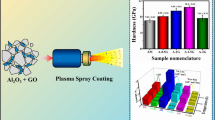Abstract
Alumina-silica composite coatings were prepared on the surface of graphite paper by chemical vapor deposition using AlCl3/SiCl4/H2/CO2 as precursor in the temperature range of 300 to 550°C. X-ray diffraction (XRD) and scanning electron microscopy (SEM) were used to examine the phase composition and the microstructure of the coating, respectively. The results indicated that a dense, uniform, and adherent alumina-silica composite coating can be prepared on graphite paper substrate by chemical vapor deposition at 550°C. Alumina-silica composite coating is composed of particles or nodules of varying size. Each particle is often composed of a number of finer particles. The phases of the 550°C composite coating include γ-alumina and amorphous silica. The elemental chlorine content in the composite coating decreases with increasing deposition temperature. The surfaces of the alumina-silica composite coatings are affected by deposition temperature. There are some obvious micro-cracks in the 300°C composite coating, which are attributed to a mismatch of the coefficient of thermal expansion between composite coating and graphite paper. The 550°C alumina-silica composite coating can be completely turned into mullite after heat-treatment at 1350°C for 0.5 hr in argon atmosphere.
Similar content being viewed by others
References
Dzyadikevich, Y.V. and Olejnik, V.E., “The Ways of Protection of the Graphite Materials Against Oxidation,” (review),Poroshkovaya Metallurgiya, 3/4, 41–47 (1996).
Lu, W. and Chung, D.D.L., “Oxidation Protection of Carbon Materials by Acid Phosphate Impregnation,”Carbon, 40 (8), 1249–1254 (2002).
Hou, P., Basu, S.N., and Sarin, V.K., “Nucleation Mechanisms in Chemically Vapor Deposited Mullite Coatings on SiC,”J. Mater. Res., 14 (7), 2952–2958 (1999).
Sarin, V.K. and Mulpuri, R.P., “Chemical Vapor Deposition of Mullite Coatings,” U.S. Patent 5,763,008, 1998.
Nitodas, S.F and Sotirchos, S.V., “Codeposition of Silica, Alumina, and Aluminosilicates from Mixtures of CH3SiCl3, AlCl3, CO2, and H2. Thermodynamic Analysis and Experimental Kinetic Investigation,”Chemical Vapor Deposition, 5, 219 (1999).
Nitodas, S.F and Sotirchos, S.V., “Chemical Vapor Deposition of Aluminosilicates from Mixtures of SiCl4, AlCl3, CO2, and H2,”J. Electrochem. Soc., 147 (3), 1050–1058 (2000).
Nitodas, S.F and Sotirchos, S.V., “Deposition of Compositionally Graded Mullite/Alumina Coatings from Mixtures of SiCl4, AlCl3, CO2, and H2,”Adv. Mater., 15 (6), 99–104 (2003).
Yamamoto, O., Sasamoto, T., and Inagaki, M., “Effect of Mullite Coating on Oxidation Resistance of Carbon Materials with SiCgradient,”J. Mater. Sci. Lett., 19 (12), 1053–1055 (2000).
Huang, J., Zeng, X., and Li, H. et al., “Mullite-Al2O3-SiC Oxidation Protective Coating for Carbon/Carbon Composites,”Carbon, 41 (14), 2825–2829 (2003).
Damjanovic, T., Jojic-Nedeljkovic, J., Fritze, H., and Borchardt, G. et al., “Mullite Diffusion Barriers on Carbon Based Composites for High Temperature Applications,”Annales de Chimie: Science des Materiaux, 28 (Suppl.1), S71-S78 (2003).
Fritze, H., Schnittker, A., and Witke, T. et al., “Mullite Diffusion Barriers for SiC-C/C Composites Produced by Pulsed Laser Deposition,”Mater. Res. Soc. Symp. Proc., 555, 79–84 (1999).
Damjanovic, T., Leipner, H., and Argirusis, C. et al., “Sol-Gel Route for Electrophoretic Deposition of Mullite Diffusion Barriers on C/C-SiC Composites,”Mater. Sci. Forum, 453-454, 343–348 (2004).
Klug, H.P and Alexander, L.E.,X-ray Diffraction Procedures for Polycrystalline and Amorphous Materials, Wiley, New York, 687–690, 1974.
Schlichting, H.,Boundary Layer Theory, McGraw-Hill, New York, 1960.
Choy, K.L., “Chemical Vapour Deposition of Coatings,”Prog. Mater. Sci., 48, 57–170 (2003).
Lili, V.C, inHandbook of Thin Film Process Technology, Institute of Physics, Bristol (UK), p. B1.0:12, 1995.
Nitodas, S.F and Sotirchos, S.V., “Homogeneous and Heterogeneous Chemistry Models of the Codeposition of Silica, Alumina, and Aluminosilicates Development and Experimental Validation,”J. Electrochem. Soc., 149 (11), C555-C566 (2002).
Bradford , B.W. ,J. Chem. Soc., 1557 (1933).
Givargiaov, E.J.,Current Topics in Materials Science, North-Holland, New York, p. 91, 1978.
Author information
Authors and Affiliations
Corresponding author
Rights and permissions
About this article
Cite this article
Chen, Z., Li, M. & Shi, Y. Alumina-silica composite coatings on graphite by CVD at 550°C. J Coat Technol Res 3, 231–235 (2006). https://doi.org/10.1007/BF02774512
Issue Date:
DOI: https://doi.org/10.1007/BF02774512




